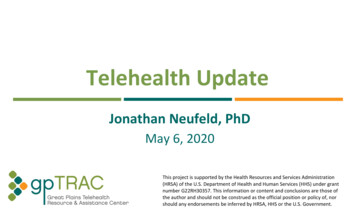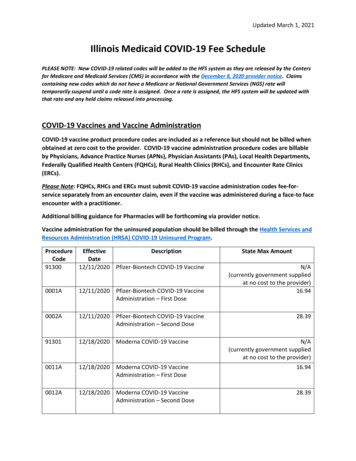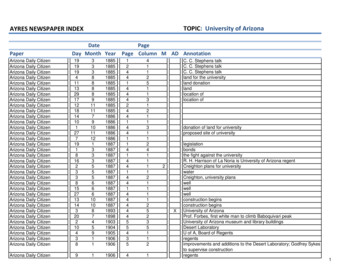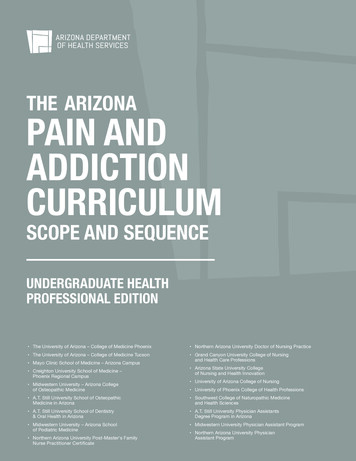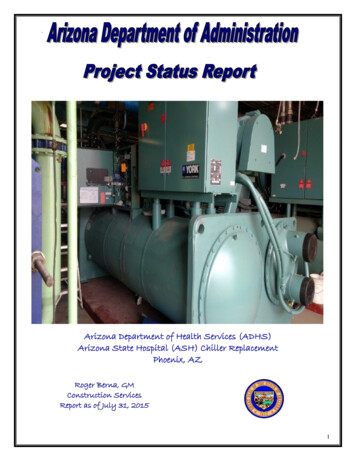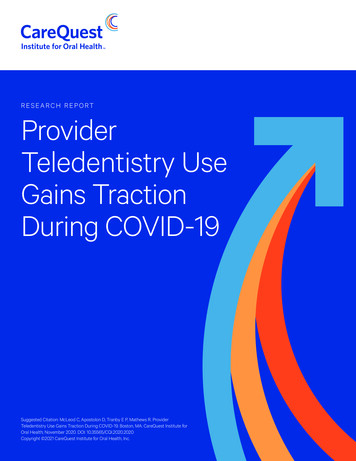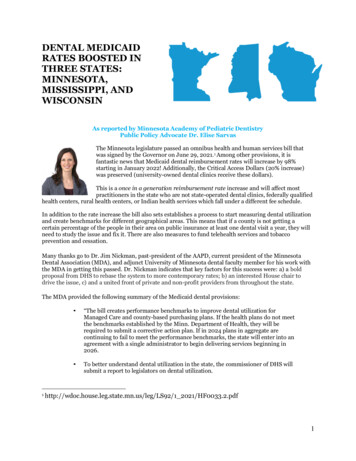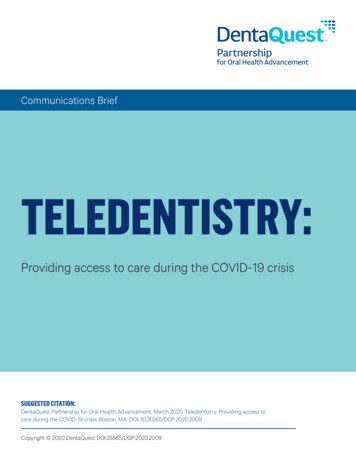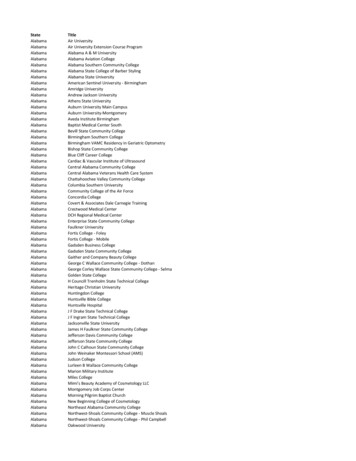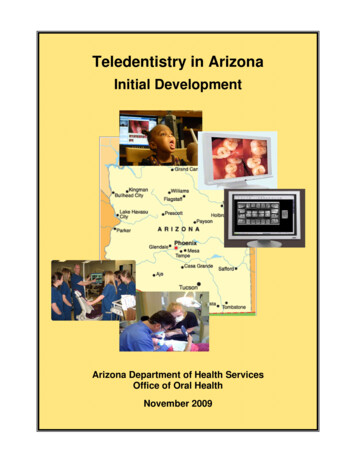
Transcription
Teledentistry in ArizonaInitial DevelopmentArizona Department of Health ServicesOffice of Oral HealthNovember 2009
AcknowledgementsArizona Department of Health Services, Office of Oral Health150 North 18th Ave. Suite 320Phoenix, AZ 85007602‐542‐1866Julia Wacloff, R.D.H., M.S. Chief, Office of Oral HealthJulie M. W. Tang, D.M.D., M.P.H. Grant Technical AdvisorPartners:Arizona School of Dentistry and Oral HealthHopi Health Care Center Dental ProgramNorthern Arizona Council of Governments Head StartNorth Country HealthCareNorthern Arizona University Dental Hygiene DepartmentScottsdale Healthcare & Community Health Services Neighborhood Outreach Action for Health ProgramsThis publication and the project described herein were made possible by Grant NumberT12HP07705 from the U.S. Department of Health and Human Services, Health Resources and ServicesAdministrationIts contents are solely the responsibility of the authors and do not necessarily represent the official views of HealthResources and Services Administration or Arizona Department of Health Services.Permission is given to photocopy this publication or to forward it, in its entirety, to others. Requests for permissionto use all or part of the information contained in this publication in other ways should be sent to the above address.
Teledentistry in ArizonaInitial DevelopmentTable of ContentsA. Introduction and Background Information .11. Introduction 22. The Basics of Teledentistry 33. The First Teledentistry Providers in Arizona 7B. Teledentistry Technology: Lessons Learned .141. Teledentistry Hardware and Software .15C. Care Delivery Supported by Teledentistry: Lessons Learned 231. Teledentistry in a School-Based Preventive Program 242. Increased Service Delivery Using Teledentistry .303. Care Coordination Supported by Teledentistry 354. Teledentistry for Care of Patients with Special Needs 425. Training of Dental Hygiene Students in Teledentistry 486. Teledentistry at a Free Annual Kiddie Clinic 527. Teledentistry for Head Start & Community Outreach . .558. Introducing Teledentistry through a Business Model 589. Teledentistry Communication . 66D. Future Efforts 691. Future Efforts to Advance Teledentistry in Arizona .70E. Appendices .72Appendix A: Regulations 73Appendix B: Reimbursement .75
Teledentistry in ArizonaSection AIntroduction andBackground Information1
Teledentistry in ArizonaSSeeccttiioonn AA // CChhaapptteerr 11IInnttrroodduuccttiioonnIn 2006, Arizona Department of Health Services, Office of Oral Health (OOH) was awarded aHealth Resources and Service Administration (HRSA) grant: Grants to States to Support OralHealth Workforce Activities. The grant funded the OOH project to increase access to dentalcare for underserved and at-risk populations through teledentistry.This manual describes the experience of thegrant project, reports the progress made by thefirst five teledentistry providers in Arizona, andshares the learned lessons in the installationteledentistry hardware/software and use ofteledentistry technology in supporting dental care.Efforts will continue among the five Arizonateledentistry providers to integrate the technologyinto their programs to provide quality and efficientcare to their patients. With a new HRSA grantawarded to the OOH for 2009-2012, OOH willalso continue to advance teledentistry in Arizona.This teledentistry manual offers a resource forproviders, agencies/organizations, communitygroups, program administrators, decision-makers,funders, and other partners and stakeholders oforal health care to learn together. The manual offers building blocks for further development ofteledentistry as a viable approach to improving access to dental care for the underserved andat-risk populations.The OOH would like to acknowledge and thank the following contributors in their support anddevelopment of this manual: Health Resources and Services Administration, Bureau of Health Professions, Grantsto States to Support Oral Health Workforce Activities, Grant No. T12HP07705 The five initial teledentistry providers in Arizona: oHopi Health Care Center Dental ProgramoNorthern Arizona Council of Governments Head StartoNorthern Arizona University Dental Hygiene DepartmentoNorth Country HealthCare Dental Services in collaboration with A.T. StillUniversity, Arizona School of Dentistry and Oral HealthoScottsdale HealthCare & Community Health Services System NeighborhoodOutreach Action for Health ProgramArizona Department of Health, Office of Oral Health staff and consultants2
Teledentistry in ArizonaSSeeccttiioonn AA // CChhaapptteerr 22TThhee BBaassiiccss ooff TTeelleeddeennttiissttrryyTeledentistry – Definitions and DescriptionsTeledentistry is a developing area of dentistry that integrates electronic health records,telecommunications technology, digital imaging, and the Internet to link dental providers andtheir patients. Several definitions and descriptions of teledentistry are found in the literature andin communications, each highlighting aspects of teledentistry: Teledentistry is the practice of using video-conferencing technologies to diagnose andprovide advice about treatment over a distance.1 Teledentistry uses computermediated technology for treatingindividual patients at a distance.2 Teledentistry, through the use oftelecommunication andcomputer technologies, providesinteractive access to specialistopinion that is not limited by theconstraints of space and time. 3 Teledentistry harnesses the realtime capability of moderntelecommunications to allow offsite dentists of any specialty toassist their colleagues inproviding care.4 Teledentistry has come to mean the use of electronic information andtelecommunications technologies to support long-distance clinical oral health care,patient and professional health-related education, public health, and healthadministration.5 Teledentistry is using the Internet to consult with an expert. This consultation could bedirect (between the patient and the expert) or indirect (between the patient’s doctor andthe expert).6 Teledentistry will be the clinical dimension of the new patient-doctor relationship. Adefinition of telemedicine helps identify the emerging realm of teledentistry: “ thecombined use of telecommunications and computer technologies to improve theefficiency and effectiveness of health care services by liberating caregivers fromtraditional constraints of space and time and empowering consumers to make informedchoices in a competitive marketplace”7Teledentistry’s roots lie in telemedicine; therefore, teledentistry fits into several definitions oftelemedicine. For example, the Association of American Medical Colleges (AAMC) described3
telemedicine as the use of telecommunications technology to send data, graphics, audio, andvideo images between participants who are physically separated (i.e., at a distance from oneanother) for the purpose of clinical care.8 The American Telemedicine Association definedtelemedicine as the use of medical information exchanged from one site to another viaelectronic communications to improve patients' health status.9 The federal government, in its1997 Telemedicine Report to Congress, defined telemedicine as the use of electroniccommunication and information technologies to provide or support clinical care at a distance.10Dentistry can look to telehealth and telemedicine to incorporate some of the necessary lessonsthat will aid teledentistry’s evolution into new health delivery models.Teledentistry ServicesTeledentistry can be integrated in general dental practice and specialty practices. Teledentistryservices would be part of a larger investment by health care practices, organizations, andinstitutions in information technology or the delivery of clinical care. Like telemedicine,teledentistry can provide different types of programs and services for the patient. The followingteledentistry services could evolve from current telemedicine practices:11 Specialist referral service involves a specialist assisting a general practitioner todiagnose and manage a patient. This may involve a patient "seeing" a specialist over alive, remote consult or the transmission of diagnostic images and/or video along withpatient data to a specialist for viewing later. (Almost 50 medical subspecialtiessuccessfully use telemedicine for referrals.) Patient consultation uses telecommunications to provide medical and dental/oralhealth data, which may include audio, still or live images. Data is exchanged between apatient and a health professional for use in rendering a diagnosis and treatment plan.This may originate from a remote site to a “home” dental office/clinic. Communicationmay use a direct transmission link or the Internet. Remote patient monitoring uses devices to remotely collect and send data to amonitoring station for interpretation. Telemedicine has used remote monitoring for "hometelehealth" applications (e.g., monitoring specific vital signs or other indicators forhomebound patients) and to support nursing visits. Professional education provides continuing education credits for health professionalsand delivers special health education seminars for targeted groups in remote locations. Consumer medical and health information includes the use of the Internet forconsumers (patients) to obtain specialized health information and on-line discussiongroups to provide peer-to-peer support.Teledentistry Delivery MechanismsThe different ways of how providers and patients can connect shows several deliverymechanisms to provide the teledentistry services described above. Telehealth and telemedicinehave used the following delivery mechanisms, which could be developed to support teledentistryservices:114
Networked programs link hospitals and clinics with outlying clinics and communityhealth centers in rural or suburban areas. The links may use dedicated high-speed linesor the Internet for telecommunication links between sites. Point-to-point connections using private networks. These connections are used byhospitals and clinics that deliver services directly, or contract out specialty services toindependent providers, at ambulatory care sites. Primary or specialty care to the home connections involves connecting primary careproviders, specialists and home health nurses with patients using single line phonevideo systems for interactive clinical consultations. Home to monitoring center links are used for patient monitoring, home care andrelated services that provide care to patients in the home. Often normal phone lines areused to communicate directly between the patient and the center although somesystems use the Internet. Web-based e-health patient service sites provide direct consumer outreach andservices over the Internet. Under telemedicine, these include sites that provide directpatient care.Potential Benefits of TeledentistryTeledentistry offers innovative prospects in the delivery of dental care and has the potential toenhance the current practice of dentistry. However, teledentistry has been underused as ameans of diagnosis and referral in dentistry. Through the exchange of clinical information overdistances, teledentistry can facilitate the delivery of dental care in areas underserved by dentalpractitioners, and therefore overcome social and geographic barriers. A greater number ofpatients can be assessed and treated. Teledentistry has the potential to achieve the threefundamental benefits of telehealth and telemedicine:11 Improved access – For over 40 years,telemedicine has brought healthcare services topatients in distant locations improving access andallowing physicians and health facilities expandtheir reach. Cost efficiencies – Adopting telehealth andtelemedicine technologies have shown to reducethe cost of healthcare and increase efficiencythrough better management of chronic diseases,shared health professional staffing, reducedtravel times, and fewer or shorter hospital stays. Patient demand – The greatest impact oftelemedicine is on the patient, their family and their community. More than 15 years ofstudies have documented patients’ satisfaction and support for telemedical services thatoffer access to providers and reduce the need to travel long distances.Teledentistry has the ability to improve access to care, improve the delivery of health care, andlower its costs. Teledentistry can be a much needed resource for dental consulting, referral forspecialized care, dental mentoring, dentist-laboratory communications, and continuingeducation.12-195
17.18.19.Cook J. ISDN video conferencing in postgraduate dental education and orthodontic diagnosis.Learning Technology in Medical Education Conference 1997 (CTI Medicine). 1997:111–6.Curts, EK. Exploring teledentistry – a new horizon in dental care? AGD Impact. 2009;37(7):34.Available at: http://www.agd.org/publications/articles/?ArtID 5798Joshi V. Teledentistry: E-consultations. Dentistry Magazine. 9 February 2002. Available rndt J, Leone P, and King G. Using teledentistry to provide interceptive orthodontic services todisadvantaged children, Am J Orthod Dentofacial Orthop. 2008;134(5):700-6. Available dentistry.htmDouglas Manning, Florida State Oral Health Improvement Plan (SOHIP) Teledentistry WorkgroupChair, in the 2006 Florida Department of Health white paper Teledentistry as a Method to ImproveOral Health Access in Florida.Glenn T. Clark, DDS, MS, Teledentistry: what is it now, and what will it be tomorrow? J Calif DentAssoc. 2000;28(2):121-7. Available at:http://www.cda.org/Library/cda member/pubs/journal/jour0200/now.htmlBauer JC, Brown WT. The digital transformation of oral health care: teledentistry and electroniccommerce. J Am Dent Assoc. 2001;132(2):204-9. Available at:http://jada.ada.org/cgi/reprint/132/2/204Chen JW, Hobdell MH, Dunn K, Johnson KA, Zhang J. Teledentistry and its Use in DentalEducation. J Am Dent Assoc. 2003;134(3):342-46.American Telemedicine Association Website. Telemedicine defined. Available cfm?pageid 3333. Accessed on October 22,2009.Telemedicine report to Congress: executive summary. January 1997. Available at:www.ntia.doc.gov/reports/telemed/execsum.htm. Accessed October 22, 2009.American Telemedicine Association. What is telemedicine & telehealth? Available uttelemedicine/What Is Telemedicine.pdfKopycka-Kedzierawski DT, Billing RJ. Teledentistry in inner-city child-care centers. J Telemedicineand Telecare. 2006;12(4):176-82.Sfikas PM. Teledentistry: legal and regulatory issues explored. Am Dent Assoc.1997;128(12):1716-18.Foke LE. Teledentistry: an overview. Tex Dent J. 2001;118(1):10-18.Golder DT, Brennan DA. Practicing dentistry in the age of telemedicine. J Am Dent Assoc.2000;131(6):734-44.Allokian M. The neglected epidemic and the surgeons general report: a call to action for better oralhealth. Am J Public Health. 2000; 90(6):843-5.Chang SW, Plotkin DR, Mulligan R, et al. Teledentistry in rural California: a USC initiative. CalifDent Assoc J. 2003;31(8): 601-8.Zeigler J. Telemedicine starts to pay off. Bus Health 1995;13(10):47-50.Phase I clinical teledentistry evaluation, S.E. Dental Service Support Area. Available at:http://tdent.tatrc.org/ldl/nfpaper.htm. Accessed March 29, 20006
Teledentistry in ArizonaSSeeccttiioonn AA // CChhaapptteerr 33TThhee FFiirrsstt TTeelleeddeennttiissttrryy PPrroovviiddeerrss iinn AArriizzoonnaaFive Arizona Teledentistry Provider SitesAs of November 2009, five dental service delivery sites in Arizona are using teledentistrytechnology. These are the first Arizona teledentistry providers (see map below):1. Hopi Health Care Center Dental Program (Hopi)2. Northern Arizona Council of Governments Head Start (NACOG)3. Northern Arizona University Dental Hygiene Department (NAU)4. North Country HealthCare Dental Services in collaboration with Arizona School ofDentistry and Oral Health (NCHC/ASDOH)5. Scottsdale HealthCare & Community Health Services, Neighborhood Outreach Actionfor Health Program (NOAH) Polacca2345741
These Arizona teledentistry providers, located in rural and urban areas, are in the early stagesof developing their teledentistry models. With the support of the HRSA workforce grant (20062009), teledentistry equipment, hardware and software programs, were purchased and installed.One of the sites went live with the technology in 2008; the other four sites went live in 2009. Allproviders will further integrate teledentistry technology into their dental practice and exploreapproaches to service delivery (e.g., community outreach efforts). These providers, usingmultiple sites to deliver dental services, have different practice settings such as a portableschool-based program, a school-based fixed dental clinic, a community-based health center,and a private dental practice. The five teledentistry providers have identified barriers andindicated that more support and time are needed to advance teledentistry in their programs andpractices.A Framework for TeledentistryThe initial efforts for the first Arizona teledentistry providers varied in their focus of using thetechnology to build capacity in their program’s dental service delivery. Each of the fiveproviders contributed to learning one or more aspects of teledentistry and together supportedthe following framework for teledentistry.Home Dental al StaffPatient PopulationClinical ServicesTeledentistry traoral CameraConsultationIntraoral CameraTreatment PlanDigital Radiographic EquipmentPortable X-Ray UnitCare CoordinationSoftwareDental Practice ManagementSoftwareImaging SoftwareReferralConsumer EducationProfessionalContinuing EducationSatellite Dental FacilityClinical StaffPatient PopulationClinical ServicesA diagram for each of the initial Arizona teledentistry models is presented below. Themodels will evolve for each provider as teledentistry advances for their program.8
Hopi Health Care Center’s Teledentistry ModelThe Hopi Health Care Center (HHCC), an IHS Service Unit, isa critical access hospital that offers diverse services includingdental care to 28,000 eligible patients. The HHCC is centrallylocated on the Hopi Reservation. The HHCC School-basedPreventive Dental Program, in full operation since September2008, uses teledentistry to support diagnostic, preventive andtemporary restorative care for children in all six elementaryschools on the Hopi Reservation. The Teledentist is a pediatricdentist and the Teledentistry Coordinator is a dental hygienistwith a MPH (a Commissioned Corp Officer with the USPHS, IHS Division). At each school,children are provided with dental services onsite (include x-rays, intraoral photographs,prophylaxis/scaling, fluoride applications, dental sealants, temporary fillings, oral hygieneinstruction, oral health education, and sport mouthguards). Further care is coordinated with theHHCC dental clinic. The mobile dental program relocates to each of the six schools. Thefollowing is HHCC’s teledentistry model.Hopi Health Care Center (HHCC) – IHS Service Unit:HHCC Dental ClinicHHCC Dental ProgramInformationTechnology14-chair dental clinic1 Pediatric Dentist (Teledentist); 4General Dentists; 2 Dental Hygienists;13 Dental Assistants; 1 Receptionist(all FTEs)Visiting specialists, volunteer dentistsand dental/dental hygiene studentsClinical services include preventive,restorative, oral surgery, prosthetic,periodontal, and endodontic care.HHCC has its ownIT Department tosupportteledentistry.The Center uses amedical system(RPMS) tomanage patientscheduling andbilling.Care CoordinationTeledentistry HardwareExtraoral CameraAcclaim Intraoral CameraNOMAD Portable X-ray UnitScanX Duo Digital Imaging SystemHHCC School-BasedPreventive DentalProgram coordinatescare for all elementaryschool children withthe HHCC Dental Clinic.Teledentistry SoftwareTigerview (imaging software)Open Dental (practice managementsoftware)HHCC School-Based Preventive Dental Program Serves 6 Schools on the Hopi Reservation:Portable dentalequipment is brought tothe schools, allowing fortwo dental operatory setups at the school facility.School Based Preventive ProgramA dental hygienist collectsoral health data that includescharting, digital radiographsand intra-oral films.The data is stored andforwarded to the HHCCpediatric dentist for diagnosisand treatment planning.Northern ArizonaUniversity dental hygienestudents and faculty alsoprovide school-basedpreventive services.Clinical services includediagnostic, preventive, andtemporary restorative care.9
Northern Arizona Council of Governments Head Start’sTeledentistry ModelNorthern Arizona Council of Governments(NACOG) Head Start program is a non-profitorganization providing comprehensiveprogramming to low income children (birth to agefive) and families throughout Apache, Navajo,Coconino and Yavapai counties. NACOG HeadStart provides services to over 1,585 preschoolage children and 124 prenatal moms, infants andtoddlers at twenty-six local centers in the fourcounty areas. The program is centrally managedfrom Flagstaff, AZ. NACOG Head Start’s servicearea covers 27,000 square miles of rural northern Arizona not including the Navajo Nation.While eight of the centers are located within a thirty minute drive from Flagstaff, many centersare located one to more than three hours of drive time from Flagstaff (one-way travel). Currentlychildren living in Navajo or Apache counties who require specialized services from a pediatricdentist must travel to either Flagstaff or Phoenix for care. The following model is NACOG HeadStart’s first initiative to integrate teledentistry into its program to address pediatric dental care.Remote (Local) Sitein NACOG Rural Service AreaPediatric Dental Officein Flagstaff, ArizonaPediatric dentist(contracted by NACOG HeadStart) receives referral fromremote site.Local general dentistrefers Head Start child topediatric dentist inFlagstaff.Oral health assessmentscheduled in remote(local) location bytrained staff.Trained dental stafftravel to remote site andcollect oral health datausing teledentistryequipment. Staff storeand forward data topediatric dentist.Pediatric dentist examinesthe oral health data(radiographs, intra-oral films,charting, etc.) to diagnose,complete treatment plan, anddetermine treatmentschedule.Pediatric dentist travels to remote siteto treat the child (has an arrangementto use a local provider’s office).Pediatric dentist provides treatment tomultiple children during the visit.A parent and child having to drive to Flagstaff for a dental examination and one subsequenttreatment visit with the pediatric dentist may mean 12 travel hours and two missed work dayswith additional transportation cost. NACOG’s teledentistry model reduces these barriers to care.10
Northern Arizona University’s Teledentistry ModelUtilizing technologies that currently exist, a boardcertified and licensed dental hygienist can collectand digitally transmit all subjective and objectivediagnostic data to a distant dentist for diagnosisand prescription of dental hygiene services.Northern Arizona University (NAU) dental hygienestudents are being trained to use such teledentistrytechnology to acquire and transmit charting, intraoral films, radiographs, etc. to a distant supervisingdentist. The NAU faculty dentist will receive all ofthe digital diagnostic data (including the student'sdental hygiene diagnosis), make a dentaldiagnosis, develop a dental hygiene treatment planwith the distant student, and provide appropriate referrals. Dental hygiene services will then beprovided under direct faculty supervision by the student. The patient will be referred as directedby the distant dentist. Teledentistry broadens the scope of dental hygiene practice by allowingproperly trained dental hygienists to provide services to new and existing patients of record inunderserved communities. The following is NAU’s teledentistry model.11
North Country HealthCare and Arizona School of Dentistry & Oral Health’sTeledentistry ModelNorth Country HealthCare (NCHC) providescomprehensive, preventive primary care, dental care,outreach programs, and training/education services topeople of Northern Arizona. Ten NCHC sites acceptMedicaid and offer a sliding fee-scale. Patients rangefrom the very young to seniors, including individuals withspecial needs as well as the mentally and physicallychallenged. The NCHC and Arizona School of Dentistryand Oral Health (ASDOH) at A.T. Still University haveestablished a collaboration to integrate teledentistry forthe care of patients with special needs and forprofessional development. ASDOH maintains a Special Care Dental Clinic. Teledentistry will beused to support the care of patients with special needs, allowing NCHC providers to consult withspecialists at ASDOH. NCHC is also a training site for the Lutheran Medical Advanced GeneralDentistry Program, ASDOH and Northern Arizona University Dental Hygiene Program.Teledentistry will be integrated into the training for residents/students and to provideprofessional continuing education that targets the NCHC telemedicine network/satellite sites.The following NCHC/ASDOH model illustrates the integration of teledentistry:Health Service and Information Technology (IT) Infrastructure- North Country HealthCare Dental Clinics- A.T. Still University IT Department- AZ School of Dentistry & Oral Health Special Dental Care Clinic- North Country HealthCare Health IT DirectorNorth Country HealthCareDental ServicesTeledentistry CoordinatorDr. Kimberly BarnesDental Clinic Director3 Dental Clinics and 5 Staff DentistsPatientsChildren & adult patientsincluding patients with complexmedical conditions & special needsClinical ServicesFull scope of dental careTraining/Rotations at NorthCountry Dental ClinicLutheran Medical Advanced GeneralDentistry ResidentsArizona School of Dentistry and OralHealth StudentsNorthern Arizona University DentalHygiene StudentsAdditional Providers/FacilitiesTelemedicine provider network atten NCHC satellite sitesHardwareAcclaim Intraoral CameraScanX Duo Imaging SystemImagingRadiographyAssessmentMonitoringAZ School of Dentistry & OralHealth at A.T. Still UniversityTeledentistry CoordinatorDr. Maureen RomerDirector of Special Care DentistrySpecial Care Dental ClinicProvides comprehensive dental careto patients with special needsthroughout the state.ConsultationTreatment PlanCare CoordinationASDOH FacultyProvides consultations to staffdentists, residents and inuingEducationSoftwareDENTRIX(practice managementsoftware)12ASDOH Dental StudentsRotations at North CountryHealthCare will include training intreating patients with special needsand teledentistryProfessional Continuing EducationProvides presentations and trainingworkshops.
Neighborhood Outreach Action Health Program’s Teledentistry ModelScottsdale HealthCare, a hospital system, operates two healthcare centers as part of its community outreach, theNeighborhood Outreach Action for Health Program (NOAH). Adental clinic is set up in each center as NOAH’s commitmentto integrate oral health into primary care. All children seen inthe adjacent medical clinic are given a dental appointmentafter their well-child visit. NOAH provided 2,500 preventivedental visits in 2008-2009. Initially, teledentistry will beintegrated into the NOAH system: (1) to share radiographs andintra-oral photographs with specialists for patient referrals, and(2) for care coordination with the two NOAH dental clinics toimprove time management and efficiency for care deliverysince the dentists are part-time at both sites. Currently, NOAHis calibrating the dental team’s use of teledentistry: theaffiliated practice dental hygienist collects oral health data forthe dentist to diagnose and complete a treatment plan. AsNOAH dental services expand, teledentistry will become anintegrated part of community outreach efforts. The following model illustrates NOAH’s initialteledentistry integration into its school-based and school-linked dental services.NOAH Health Service InfrastructureNOAH is part of the Community Outreach for theScottsdale Healthcare Hospital System. The entirehospital infrastructure is available for support services.NOAH Information Technology InfrastructureThe Scottsdale Healthcare hospital system‘sInformation Technology Department providessupport to the NOAH clinics and teledentistry.HardwareSchool-linked Dental Clinic atPaiute Neighborhood CenterClinical StaffAffiliated Practice Dental HygienistPart-time Dental HygienistPart-time General DentistsDental AssistantPatient PopulationPrior 10/2009: children age 0-18As of 10/2009: Children age 21Clinical ServicesPreventive & restorative careSupport ServicesTransportation (taxi) for familiesAcclaim Intraoral CameraNOMAD Portable X-ray UnitScanX Duo Imaging eTigerview (imaging software)Open Dental (practice managementsoftware)School-based Dental Clinic atPalomino Elementary SchoolClinical StaffAffiliated Practice Dental HygienistPart-time Dental HygienistPart-time General DentistsDental AssistantPatient PopulationPrior 10/2009: children age 0-18As of 10/2009: Children age 21Clinical ServicesPreventive & restorative careSupport ServicesTranspo
Arizona Department of Health Services, Office of Oral Health 150 North 18th Ave. Suite 320 Phoenix, AZ 85007 602‐542‐1866 Julia Wacloff, R.D.H., M.S. Chief, Office of Oral Health Julie M. W. Tang, D.M.D., M.P.H. Grant Technical Advisor Partners: Arizona School of Dentistry and Oral Health
